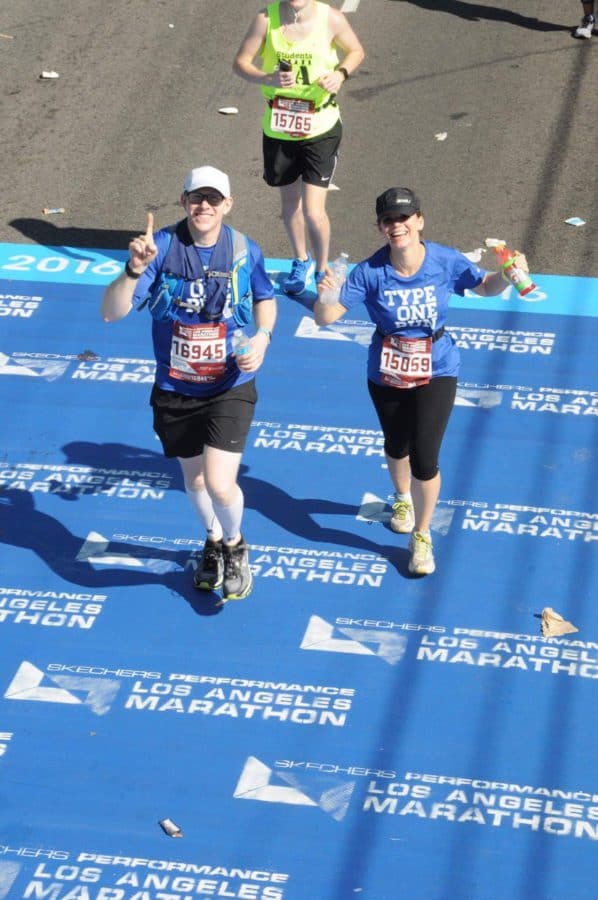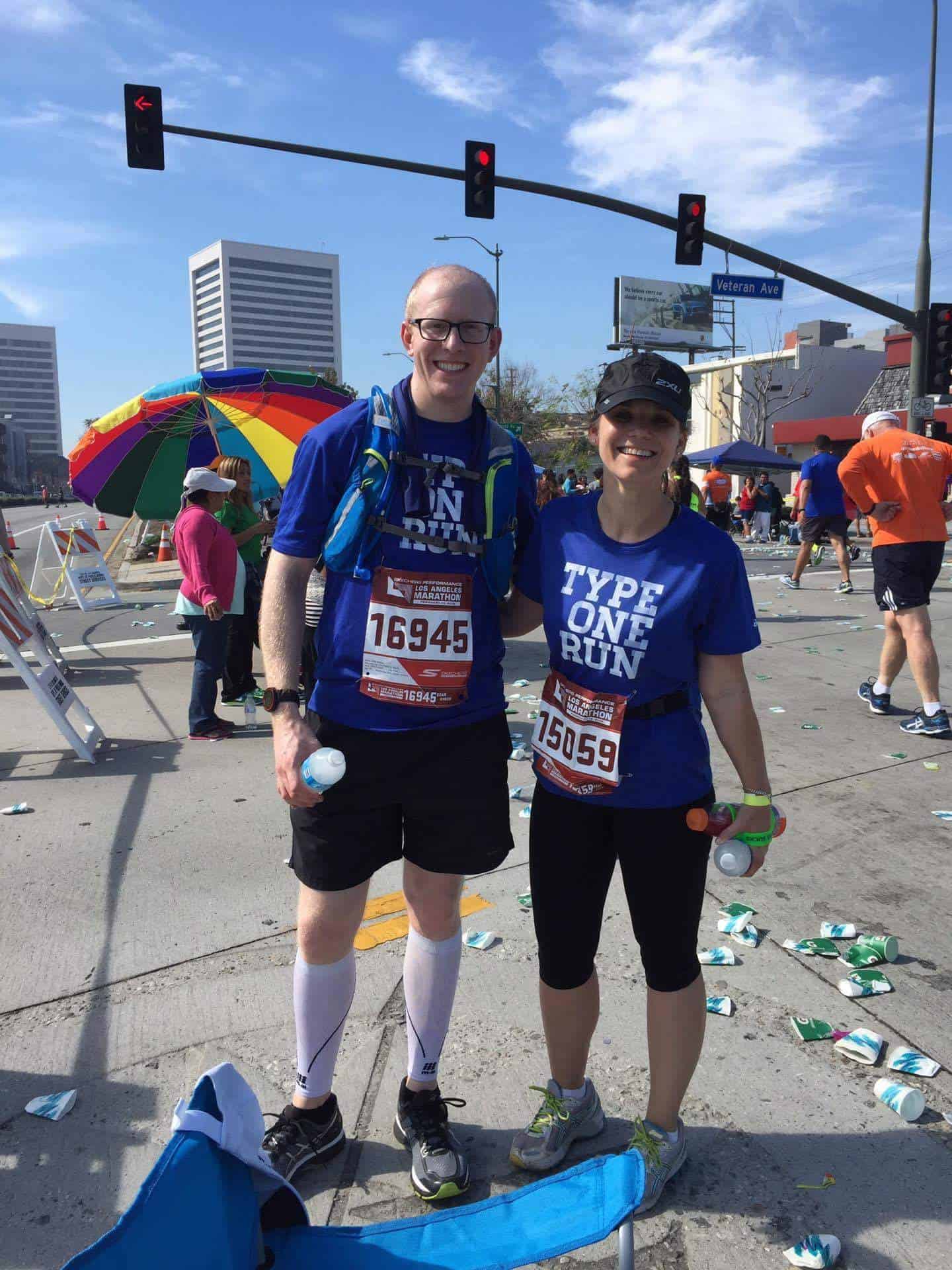Words by Reny Partain | Photos by Hank Devos and Virtue Bajurny
We were meeting with our local JDRF Young Leadership Committee, trying to brainstorm ways to raise money for research dedicated to finding a cure for Type 1 diabetes when a good friend jokingly said, “Let’s run the LA Marathon!”. I had never run more than 5 miles before in my life, so I laughed and sarcastically responded, “Sure, no problem.” Several members in our Type 1 group had run marathons before and immediately began throwing out training suggestions. By the end of the night, our conversation had turned to many other topics, like debating exactly how many grams of carb were in the bacon wrapped dates, and the idea of running a marathon fell to the wayside where I thought it would stay
A few days later I received a group text saying that my friends were serious about running the next LA Marathon, but were leaving the final decision up to me. I think it took me all of 30 seconds to respond that I was in and before I knew it, we had a shared Google calendar with training runs scheduled for the 9 months leading to the marathon. The people who know me well probably think I’m making this up because I never make snap decisions about anything. Whether it’s what graduate school to attend or what dish to order at a restaurant, I weigh the pros and cons of each option in painstaking detail before carefully selecting the winner. Call it a side-effect of living for 25 years with a chronic illness, but taking the time to analyze, prepare, and plan before acting has always gotten me through life’s challenges. It had also kept me from trying new things that felt risky or uncertain.
Running a marathon was a life goal I made back in high school that I had slowly been talking myself out of since. Every time I would consider signing up, I became overwhelmed by the things that could go wrong- how would I handle more lows, would anyone run with me if I was stopping constantly to check my blood sugar, how in the world could I carry low food for 26.2 miles worth of running- and suddenly I had talked myself out of it before I went on a single run. So when that group text popped up on my phone, I told myself it was ok to not know exactly how I was going to do it. I just needed to go for it. All of this was further reinforced by my endocrinologist’s reaction when I first told her I was going to run a marathon. “Do you really need to train for 9 months?” she asked. “I only ask because I know marathons can really be hard on people’s knees…” And with that I was off and running.
My first 10 mile training run was ugly. My Dexcom sensor spent the first hour of the run more than 100 points off from my meter reading, I had senior citizens passing me in the bike lane, and by mile 8 every muscle in my legs ached. But I ran it. Each run I completed I learned more about how my body reacted to different levels of physical activity and stress. I found that no matter what my blood sugar was before a run, a bagel with peanut butter was the perfect thing to eat 30 minutes prior to hitting the pavement. And that if I didn’t have enough carbohydrate in my system during a run I would start spilling ketones even with in-range numbers. I also learned that my friends were more than happy to take a break when I needed to check my blood sugar or pound a pack of fruit gummies during a low.
Having a Dexcom sensor was an amazing tool that allowed me to download my data to look for trends in my blood sugars before, during, and after a run. I worked closely with my endocrinologist to develop a second basal pattern with lower basal rates that I would turn on a few hours after my runs to prevent night time lows. Before I could lower my basals, I had to get through the first few hours immediately after a run when I needed more than double my normal amount of insulin.
As the race day got closer, my endocrinologist hammered into all of us that we had to prevent all low blood sugars the 24 hours prior to the marathon at all costs. Our bodies store extra glucose in the form of glycogen in our muscles that can be released for different reasons, including a low blood sugar. However it can take time to replenish the glycogen in our system, so if you go low the day before your race, there is a chance your body won’t have enough time to replace this extra glucose store. This can make a low during a race even harder to recover from. So of course, this resulted in me becoming a walking food cart for a day while developing near pathological paranoia around checking my blood sugars. When we got to the starting line the next morning, we did a very light warm up of mostly stretching and tried to stay as calm as possible to prevent rushes of adrenaline from spiking our blood sugars. I will admit it felt pretty strange to be standing in a large crowd of people jumping and hollering while I remained standing doing my deep breathing exercises. It worked though.
I cruised through the first 13 miles of the race without incident. The next 13 miles had some lows and I learned exactly how quickly I could down 5 packs of GU Energy gels (2 minutes flat, although I really don’t recommend it). By mile 17 my blood sugars were stable, but my energy was at an all-time low from the lows. I worried about being burned out before the 20 mile marker when examining the course a few weeks before and had asked my boyfriend (who also served as my pit crew throughout the day) to hang out somewhere near mile 20 so I’d have something to look forward to. When I saw him, and the brand new bottle of Gatorade he was holding, I told myself 6 miles was nothing and I just had to keep going. I managed to cross the finish line still smiling and very thankful that I had pushed myself to reach this goal. The months of training taught me how to handle the unknowns I was so afraid of and helped me make decisions during the marathon. And in the end, my amazing friends who ran with me, my endocrinologist, and my own stubbornness to finish pushed me just enough to get through all 26.2 miles.

Good luck to all of those running in the Ottawa and Calgary races this May! It is an incredible accomplishment on its own, only made sweeter when you know you did it while managing the roller coast that can be Type 1 diabetes on top of it!

Reny Partain
Reny is pediatric social worker and health educator based out of Los Angeles with a passion for working with teens and young adults faced with chronic illness. She was diagnosed with type 1 diabetes at the age of 2 and has loved being involved with several diabetes communities including DYF, JDRF, and ADA.





